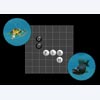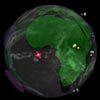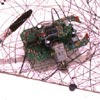Postmasters Gallery is pleased to announce John Klimaís first solo
exhibition. Titled "Go Fish," the show will consist of interactive media
installations connecting computer gaming and real life consequences.
John Klima will also be exhibiting at the Whitney Museum exhibition
"Bitstreams" (March 01) and recently received the "Golden Lasso Award
for Art," Web3d RoundUp SIGGRAPH 2000 for his project "Glasbead".
Circa 1980, Brooklyn-based Klima (b. 1965) attempted to code a
3D maze on a TRS-80 with 4k RAM and failed miserably. He has been
obsessed with 3D ever since. Fascinated by the first primitive flight
simulators and CAD programs, he began to build 3D graphics environments,
and to write source code.
By drawing upon gaming and the various possibilities of manipulating
and transliterating data, John Klima's exhibition occupies completely virgin
ground in new media art. Although there is an obvious connection between
gaming and interactive digital art, and the gaming industry has played an
important role in the development of multi-user environments, the parameters
of this connection are almost never subjected to serious, aesthetic investigation.
One of the pragmatic aspects of digital practice is that information can
be reified in various forms and modalities - - be they physical objects,
3D representations or an interactive, networked installations. "Go Fish"
traces the various manifestations of data in its migration from sound files
to 3D objects and the impact of gaming on actual and virtual life forms.
The question of "remote responsibility" raised by the results of players'
actions so far has been the domain of critical writing rather than art,
yet what was purely theoretical is here rendered utterly concrete.
"Go"
Go consists of corresponding virtual and physical gaming›
environments. Loosely based on the Japanese game Go, the goal of the›
game is to capture robots and buy drawings. The physical game board is a›
16 x 24 foot map of the earth, made from 16 x 20 inch drawing pads›
arranged in a grid on the floor. Each page in the drawing pad equates to a›
monetary denomination. The drawings on the pads are created by 4 fully›
autonomous robot bugs that run on batteries and have pens attached to them.›
Individual game board drawings can be purchased "cash and carry."›
When a robot's battery is low, it seeks light and moves into one of 8 illuminated›
robot recharging stations, which are positioned on 8 countries on the game/drawing›
board. Suspended above the game board is an 8 foot balloon. The virtual gaming›
environment, a spinning image of the earth, is projected onto this balloon.›
In the virtual game, each country (and its corresponding charging station) on the
physical game board is represented by a disk. Visitors to the gallery manipulate›
the projection interface and turn the charging stations on and off by moving little›
communication satellites into the proximity of the disks. This way, they determine›
the path of the robots and resulting drawings.
"Fish"
› Implementing the classic paradigm of the "first person 3D shooter",›
› Fish› ups the ante by placing the life of a real goldfish at stake.› The
› piece consists of a virtual gaming environment and its analog
› physical installation. The game is played from an arcade cabinet,
› requiring players to deposit a quarter. The player's goal is to get their›
› virtual goldfish avatar to the safety of the "hero tank" by traveling›
› through treacherous, predator infested waters. If the game-goldfish
› makes it to safety, a live goldfish is automatically released from a
› holding area into a large bowl with other "saved" goldfish. If it doesn't,›
› the live goldfish is released into a tank with a live oscar fish, and is›
› subsequently devoured.
"Guestbook"
› Using the artist's original 20-year-old TRS-80 computer as the gallery
› guestbook,› the visitor is asked to sign not with their name but with a
› valid credit card number.› The "mass storage device" on the TRS-80 is a
› standard audio cassette recorder, but instead of being stored to tape,
› the card number is played as a datasound (similar to modem noise)
› through a speaker. A microphone connected to a contemporary computer
› records this sound, and translates the sound data into an unique 3D
› geometrical object. The visitor may then preview the object, and (if it
› meets their approval) purchase the object as an actual, physical "3D
› print", known as a stereolithograph, that can be held in the hands or
› displayed on a shelf.
also in the gallery:
"Optimus"(analog glasbead v1)
Consisting of 16 modified radios attached to a ring and 8 small
joysticks mounted to a sphere, optimus is an analog equivalent to the
artist's popular "glasbead" digital sound object (www.glasbead.com).
Similarly to glasbead, the viewer is invited to "make it sound good" by
manipulating the joysticks. The viewer may tune the radios to any
stations and dynamically play the volumes of each radio. A wide
variety of soundscapes can be achieved through tuning to talk radio or
the white noise "between channels." The 16 radios mounted on a ring
create an intriguing sound spatialization. versions 2 and 3 of "analog
glasbead" will actualize the same concept but with greater numbers of
radios and joysticks, and a variety of radio sources such as weather,
air traffic control, police scanners, CB's etc...
|


